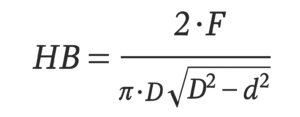

Brinell hardness testing is a trusted method for determining the hardness of metals and alloys with coarse or uneven grain structures. Especially suited for castings, forgings and larger components, the Brinell method uses a hardened steel or tungsten carbide ball to create a wide, measurable indentation. At GNEHM, we offer Brinell hardness testers that deliver accurate and repeatable results in both laboratory and production environments.
Learn more about Brinell hardness testing, or contact our specialists for personalized advice and quotes.
The Brinell hardness test is a static macro-hardness testing method used to determine a material’s resistance to permanent indentation. This method is particularly effective for materials with coarse or irregular grain structures, like:
It is widely used in metal production and heavy engineering industries and conforms to ISO 6506 and ASTM E10 standards.
A spherical ball is applied under a known force, and the diameter of the resulting impression is measured optically. After a fixed dwell time, the Brinell Hardness Number (HB or HBW) is calculated using the following formula, where F is the applied force (kgf), D is the diameter of the indenter (mm) and d is the measured diameter of the indentation (mm):

In a typical Brinell test, a 10 mm diameter steel or tungsten carbide ball is pressed into the surface of the test sample under a heavy load, usually between 500 kgf and 3000 kgf. This is the standard test force range for most Brinell applications. However, GNEHM systems can apply lower test loads down to 62.5 kgf and offer smaller diameters, depending on the configuration and material being tested.
The Brinell method is particularly suitable for bulk materials and large components with non-uniform structures, where wide indentations help average out local and internal variations.
Brinell hardness testing is commonly used in:
The Brinell method is less suitable for very thin materials or small parts where micro-hardness methods like Vickers or Knoop are more appropriate.
GNEHM offers a compact range of Brinell hardness testers built for accuracy and ease of use. Our semi-automatic machines cover a test force range from 62.5 kgf to 3000 kgf and include options for both manual and automated optical measurement. Available indenter diameters include 1 mm, 2.5 mm, 5 mm, and 10 mm, allowing for application-specific configurations depending on material type and test force.
Both models are designed for industrial performance and meet the requirements of ASTM E10 and ISO 6506.
To maintain consistent results and ensure standard compliance, GNEHM supplies a full range of Brinell consumables, including:
Explore our consumables page for more information on compatible accessories and certified components.
With decades of experience in hardness testing and Swiss precision engineering, GNEHM delivers Brinell testers you can rely on. Our solutions are:
Whether you’re looking for a standard model or tailored configuration, we help you choose the right Brinell tester for your process.
Explore our Brinell models or get in touch with our team to discuss your requirements. We’re happy to help you find the best solution for your application. Of course, you can also request a personalized quote.
Not sure if Brinell is right for you? Check out our Vickers, Knoop or Rockwell testers to compare available methods.
Brinell hardness testing is a method of determining how resistant a material is to permanent indentation by applying a heavy load with a spherical indenter and measuring the resulting impression.
A hard ball is pressed into the surface under a fixed load. The diameter of the indentation is measured and used in a formula to calculate the Brinell Hardness Number.
Brinell hardness is calculated based on the applied force, the indenter size, and the diameter of the indentation. Measurements are typically taken optically.
The HB is a numerical value that represents the material’s hardness. It is calculated using the test force and the size of the indentation. The Brinell formula: HB = 2F / (πD(D – √(D² – d²))). Where F is force, D is the indenter diameter, and d is the indentation diameter.
Because of its extreme hardness and resistance to wear, tungsten carbide ensures accurate, repeatable results, even under high test loads and during extended use.
Brinell hardness testing is suitable for materials with coarse or uneven grain structures, such as cast iron, aluminium alloys, copper, and soft to medium steels. It is especially effective for larger components and forgings that require an averaged hardness value over a wide surface.
The Brinell method offers excellent reliability for large, heterogeneous materials. It requires minimal sample preparation, provides wide indentations that average out local variations, and delivers results that comply with ISO 6506 and ASTM E10 standards. It’s ideal for heavy-duty industrial applications.